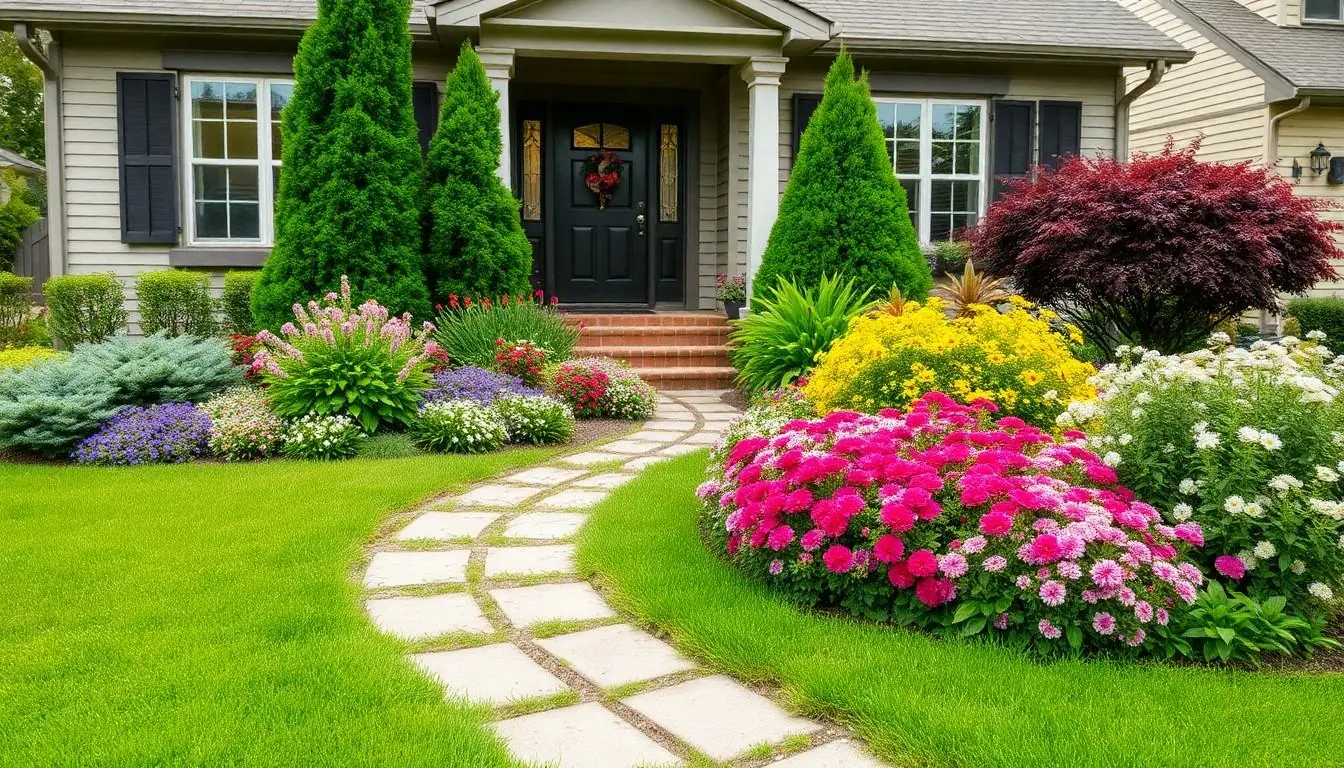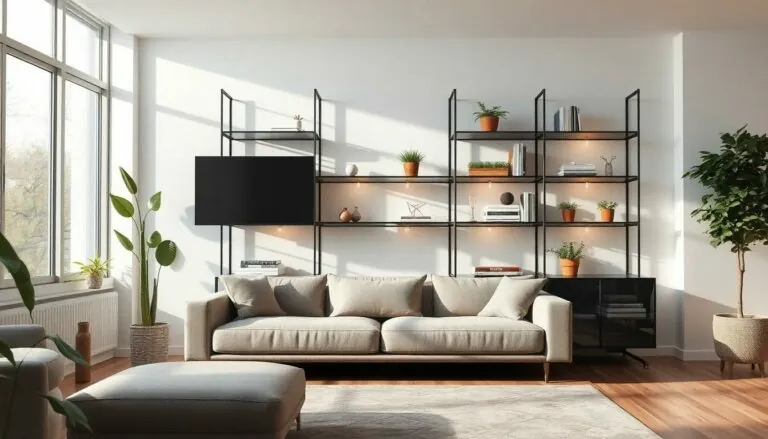A home’s front yard is like its first impression—it’s gotta look good! Choosing the right landscaping plants can transform that drab space into a vibrant welcome mat that says, “Hey, come on in!” Whether it’s a riot of color or a serene green oasis, the right plants can elevate curb appeal and even boost your home’s value.
Table of Contents
ToggleImportance of Curb Appeal
Curb appeal significantly influences a visitor’s first impression of a home. Enhancing visual appeal through landscaping invites guests to explore further. Interestingly, well-maintained plants contribute not only beauty but also character to the property. Lush greenery or vibrant flowers can set a welcoming tone. Effective landscaping can spark interest from potential buyers, influencing property value positively.
Investing in the right plants transforms the front yard into a focal point. For instance, a mix of colorful perennials and evergreen shrubs creates depth and interest year-round. It’s essential to select plants that thrive in the local climate, ensuring longevity and reducing maintenance efforts. Additionally, different plant heights can create layers, enhancing visual intrigue.
Strategically placed plants direct attention to architectural features of the home. They can also soften hardscapes, making the space feel more inviting. Colorful blooms not only captivate but can evoke emotional responses, enhancing overall satisfaction. Curb appeal extends beyond aesthetics; it reflects the homeowner’s pride and care for the property.
Consider seasonal changes when selecting landscaping plants. Diverse options, such as flowering plants for spring and foliage for fall, maintain interest throughout the year. Such choices can also provide year-round color, enhancing appeal regardless of the season. Consequently, thoughtful plant selection can transform the front yard into a vibrant and inviting space, ultimately raising the standard for curb appeal.
Choosing the Right Landscaping Plants

Choosing landscaping plants involves several key factors to ensure a successful front yard design.
Considerations for Climate
Plant selection significantly depends on local climate conditions. It’s crucial to choose species that thrive in the specific weather patterns of the region. For instance, drought-resistant plants serve well in arid areas while native plants often adapt better to local soil and moisture levels. Hardy perennials may withstand cold winters, offering seasonal color. Additionally, understanding sun and shade areas in the yard aids in selecting plants that flourish without excessive stress. Always consult local extension services or gardening centers for insights on climate-appropriate choices.
Maintenance Requirements
Maintenance plays a vital role in plant selection. Low-maintenance options suit busy homeowners and ensure ongoing beauty with minimal effort. Consider perennials over annuals for easier upkeep, since perennials return each year without replanting. It’s wise to assess the watering needs of selected plants; drought-tolerant varieties reduce time spent on irrigation. Grouping plants with similar care requirements simplifies maintenance routines. Furthermore, consider growth rates to avoid overcrowding plants in the future. Taking these maintenance factors into account enhances the long-term appeal of the front yard.
Popular Landscaping Plants for Front of House
Selecting the right plants for the front of a house enhances its visual appeal. Several popular options offer beauty and functionality.
Perennial Flowers
Perennial flowers bring vibrant colors to front yards. They bloom year after year, providing consistent visual interest. Plants like daylilies and coneflowers require minimal maintenance and thrive in various climates. They attract pollinators, boosting the local ecosystem. In addition, their diverse heights and colors create a dynamic landscape that changes with the seasons. Grouping perennials contributes to a cohesive look in the garden.
Shrubs and Bushes
Shrubs and bushes add structure to front landscapes. Varieties like boxwood and hydrangea maintain their shape and provide green backdrops throughout the year. They also offer privacy and can delineate spaces effectively. Evergreen shrubs retain their foliage in winter, ensuring year-round greenery. Mixing flowering and foliage shrubs enhances visual textures and colors. Regular trimming keeps them healthy while retaining their desired shape.
Ground Covers
Ground covers play a crucial role in landscaping designs. They prevent soil erosion and reduce weed growth while adding greenery. Options like creeping thyme and moss provide a lush carpet effect, making them ideal for pathways and under trees. Many ground covers are drought-tolerant, simplifying maintenance. They also fill in gaps between other plants, creating a seamless look in the garden. Choosing the right ground cover contributes to the overall composition and health of the landscape.
Tips for Plant Placement
Strategic plant placement enhances the front yard’s aesthetics. Position taller plants toward the back of borders to provide height and visibility. Place medium-sized plants in the middle, creating a graduated effect that adds depth. Position shorter plants at the front to frame the arrangement, ensuring each plant is visible and contributes to the overall display.
Consider the home’s architectural style when selecting plants. Organic shapes complement traditional homes, while geometric designs suit modern structures. Use color contrast to highlight features; bright flowers against dark siding can create a vibrant focal point. Utilize evergreen shrubs in strategic areas for year-round interest and structure, even in winter.
Evaluate sun and shade conditions in the front yard. Plants requiring full sunlight should go in well-lit areas, while shade-loving varieties work best under trees or overhangs. Group plants according to their watering needs to simplify care. Filling gaps with ground covers, like creeping thyme, can improve soil health and reduce weeds.
Take seasonal changes into account. Choosing plants that bloom at different times maintains visual interest throughout the year. Incorporate perennials that thrive in the local climate, ensuring sustainability without excessive upkeep. Incorporate seasonal decorations, such as pumpkins in fall, to complement plant arrangements and enhance curb appeal.
Enhancing the front yard with thoughtful plant placement cultivates a welcoming atmosphere. This approach not only elevates aesthetics but also enriches property value, creating a space that reflects pride in homeownership.
Selecting the right landscaping plants for the front of a house is essential for creating an inviting and attractive space. Thoughtful choices can enhance curb appeal while reflecting the homeowner’s care and pride. By considering local climate conditions and maintenance requirements, homeowners can ensure their plants thrive throughout the seasons.
Strategic plant placement not only highlights architectural features but also adds depth and interest to the landscape. Incorporating a mix of perennials, shrubs, and ground covers can create a cohesive look that remains beautiful year-round. Ultimately, investing in the right landscaping plants transforms the front yard into a welcoming environment that enhances the overall value of the property.





